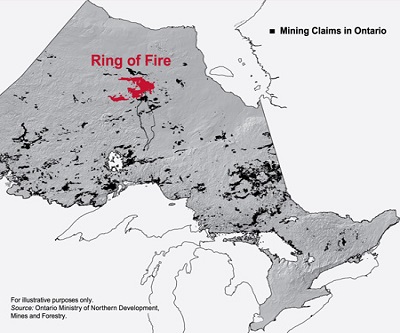Some praise Cliff’s Ring of Fire suspension, others not so much

Earlier this week, Cleveland-based miner Cliffs Natural Resources pulled out of the $3.3 billion Ring of Fire chromite project in Ontario.
Cliffs chose to indefinitely suspend the project through its subsidiary Cliffs Chromite Ontario because of the “uncertain timeline and risks associated with the development of necessary infrastructure.”
“We continue to believe in the value of the mineral deposits and the potential of the Ring of Fire region for Northern Ontario,” Vice-President Bill Boor said in a statement. “As we’ve assessed the current challenges in the region and the costs to continue on the current path, we decided to suspend the Chromite Project indefinitely.”
The company said it would continue to work with the provincial government, First Nation communities and other interest parties to resolve the issues, but did not mention a restart date.
The announcement didn’t come as much of a shock: In June the company suspended environmental assessment activities. In October, Boor told the Canadian Press that there were talks about shutting down the project because the company was having trouble building an all-weather road to the site.
Although Cliffs’ share price took a mild beating from the announcement, dropping from $27.5 per share on Wednesday to $25.5 by Friday, not everyone sees the move as a bad sign.
H. Fraser Phillips at RBC Capital Markets said on Friday that Cliffs made the right decision.
“It has been our view that the project would take years to developed if it could ultimately be developed at all,” Phillips said, as reported by the Financial Post.
With today’s’ chromite prices, Phillips seriously questioned the project’s economics.
By scrapping the Ring of Fire plans, the company can now allocate resources and capital to its iron ore project in Quebec, Phillips noted.
But the province of Ontario might take a different view. In a piece for the Toronto Sun, Christina Blizzard writes that the Ring of Fire’s “flame-out will impact all of Ontario.”
The ore-rich region in northwestern Ontario is seen as a major driver of the province’s economic boon. When Cliffs pulled out of the project it took jobs with it, closing its offices in Thunder Bay and Toronto, as well as the exploration camp site.
The project was valued at an estimated $60 billion in economic development.
Blaming a “Toronto-centric government” that “doesn’t get mining and doesn’t understand Northern Ontario,”, Blizzard writes: That clanging sound is $60 billion being flushed down a stainless steel drain.
More News
{{ commodity.name }}
{{ post.title }}
{{ post.date }}




Comments
Fred Brown
Last month, John Cumming of the Northern Miner, reported that the precedent-setting ruling by the province’s Mining and Lands Commissioner (MLC) was a win for the ‘little guy,’ as Cliffs Natural Resources lost its application for easement (surface access right-of-way) across mining claims held by KWG Resources in the Ring of Fire chromite camp of northern Ontario.
North Bay Mayor, Al MacDonald, in an interview with Markus Schwabe of CBC Morning North, on Nov 12, 2013, said that Ontario’s divestiture plan for the ONTC has placed it on life support. The mayor explained that Ontario’s creation of a development corporation is not needed. All the pieces are there already to move the ONTC into the “James Bay & Lowlands Ports Authority”.
Ontario has but one option left if it wants to move forward on the Ring of Fire.
Infrastructure Ontario and the MNDM need to become shareholders and agree to transfer it’s shares of the Ontario Northland Railway to an already created federally chartered, shell crown corporation, the “James Bay & Lowlands Ports Authority”.
Its that simple. Then all the pieces will fall into place.
KWG would then be able to privately finance the bulk of the ROF railway. It would be able to privately fund the chromite reducer and chromite mine, all located in Ontario.
Canadians and Ontarians should not be forced to pay for the railway, subsidize corporate power rates and see a large part of semi-processed natural resources leave Canada.
KWG’s plan requires no large public funding for ROF railway infrastructure (Federal 3P, 50 year low interest flow through corporate loans), no corporate power subsidies (mine, railway and chromite reducer will operate primarily on natural gas), no ministerial export exemptions (following the Finnish model, most of the chromite turned into stainless steel in Ontario).